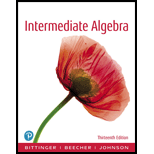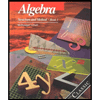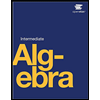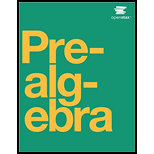
Solve:
To eliminate the
Substitute 3 for y in
We get the same result when
Want to see the full answer?
Check out a sample textbook solution
Chapter 9 Solutions
EBK INTERMEDIATE ALGEBRA
- A television show tests the abilities of alleged psychics by presenting contestants with a set of \[4\] cards placed upside down, \[1\] of which has a star printed on it. Each contestant attempts to identify which card has the star on it for a series of \[50\] trials. Assuming that the contestants are purely guessing, what are the mean and standard deviation of the number of trials where the contestant guesses correctly?You may round your answers to the nearest tenth.arrow_forwardA television show tests the abilities of alleged psychics by presenting contestants with a set of \[4\] cards placed upside down, \[1\] of which has a star printed on it. Each contestant attempts to identify which card has the star on it for a series of \[50\] trials. Assuming that the contestants are purely guessing, what are the mean and standard deviation of the number of trials where the contestant guesses correctly?You may round your answers to the nearest tenth.arrow_forwardA large fast-food chain runs a promotion where \[1\]-in-\[4\] boxes of french fries include a coupon for a free box of french fries. Suppose that some location sells \[100\] of these boxes of fries per day. Let \[X=\] the number of coupons won per day. Find the mean and standard deviation of \[X\].You may round your answers to the nearest tenth.arrow_forward
- A roulette wheel has \[38\] slots, of which \[18\] are red, \[18\] are black, and \[2\] are green. In each round of the game, a ball is tossed in the spinning wheel and lands in a random slot. Suppose we watch \[7\] rounds of this game, and let \[R\] represent the number of rounds where the ball lands in a red slot. Which of the following would find \[P(R=3)\]?arrow_forwardA small college has 800students, 10% of which are left-handed. Suppose they take an SRS of 8students. Let [L=] the number of left-handed students in the sample. Which of the following would find [P(L=2)]?arrow_forward[2 01 3. (12 pts) Let A = 1 1 and b = 1 L2 1] 213 [2] (1) (2) Use the Gram-Schmidt process to find an orthonormal basis for the column space of A. Factor A into a product QR, where Q has an orthonormal set of column vectors and R is upper triangular. (3) Solve the least squares problem Ax = b.arrow_forward
- 22.) Mr. Vedrani has a pool with a deck built around it. The equation (2x+14)(2x+19) = 650 represents the relationship of the side lengths (in feet) of the entire pool area (in square feet). a.) If 350 represents the area of the pool and deck area, what do the expressions (2x+14) and (2x+19) each represent? b.) Using graphing technology, find x, the width of the deck around the pool. If necessary, round to the nearest tenth. x=arrow_forwardHow do I get common factors?arrow_forwardProblem #1 You apply to two different graduate programs at a specific university: one in geology and one in environmental sciences. Let P(G) = 0.8, where P(G) represents the probability that you get accepted into the geology program. Let P(E) = 0.72, where P(E) represents the probability that you get accepted into the environmental sciences program. Let P(GE) = 0.65. a). Create a Venn diagram that represents this information. b). First, calculate P(GUE). Then, using complete sentence, interpret what P(GUE) represents in the context of this problem.arrow_forward
- Problem #3 Let P(G|Q) = 0.03, P(G) = 0.2, and P(Q) = 0.5. a). Find P(GnQ). b). Find P(G UQ). c). Are events G and Q independent or dependent? Explain your reasoning.arrow_forwardProblem #4 Suppose a random variable, X, has the following probability distribution table. X 1 2 3 4 5 60 P(X=x) 0.29 0.11 0.32 0.18 a). Find P(X = 5). b). Find P(2≤ X ≤4). c). Find P(2arrow_forwardProblem #5 You play a game where you have a 35% chance of winning and a 65% chance of losing (no ties are permitted). If you play the game multiple times in a row, the probability of winning and losing remains the same for each attempt. a). If you play the game 40 times, what is the probability that you lose all of the 40 games? b). If you play the game 40 times, what is the probability that you win exactly 25 times?arrow_forward
 Algebra: Structure And Method, Book 1AlgebraISBN:9780395977224Author:Richard G. Brown, Mary P. Dolciani, Robert H. Sorgenfrey, William L. ColePublisher:McDougal Littell
Algebra: Structure And Method, Book 1AlgebraISBN:9780395977224Author:Richard G. Brown, Mary P. Dolciani, Robert H. Sorgenfrey, William L. ColePublisher:McDougal Littell Elementary AlgebraAlgebraISBN:9780998625713Author:Lynn Marecek, MaryAnne Anthony-SmithPublisher:OpenStax - Rice University
Elementary AlgebraAlgebraISBN:9780998625713Author:Lynn Marecek, MaryAnne Anthony-SmithPublisher:OpenStax - Rice University

 Glencoe Algebra 1, Student Edition, 9780079039897...AlgebraISBN:9780079039897Author:CarterPublisher:McGraw Hill
Glencoe Algebra 1, Student Edition, 9780079039897...AlgebraISBN:9780079039897Author:CarterPublisher:McGraw Hill Mathematics For Machine TechnologyAdvanced MathISBN:9781337798310Author:Peterson, John.Publisher:Cengage Learning,
Mathematics For Machine TechnologyAdvanced MathISBN:9781337798310Author:Peterson, John.Publisher:Cengage Learning,





